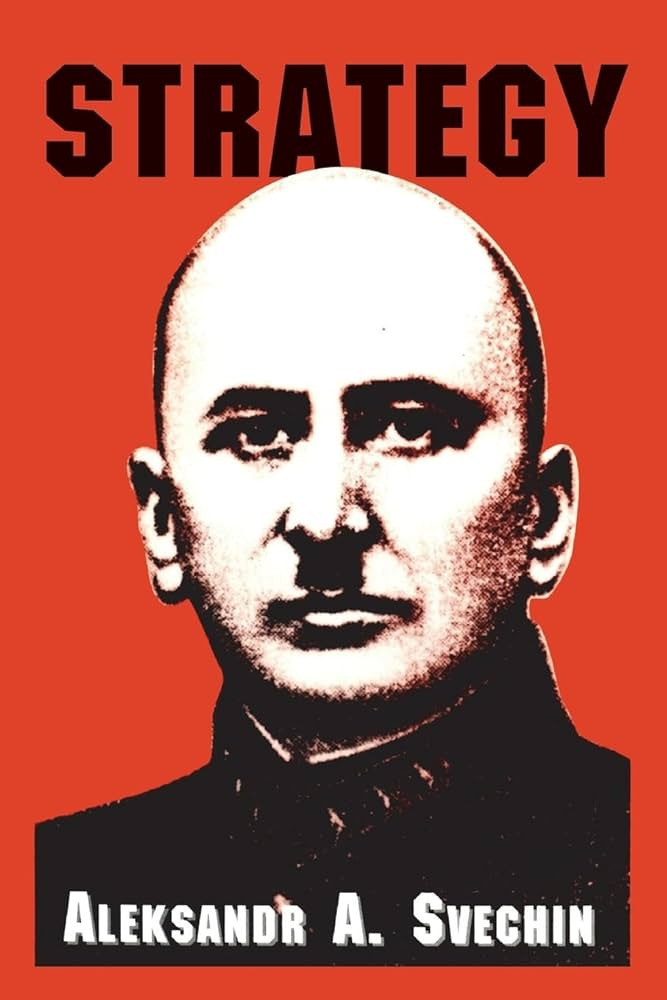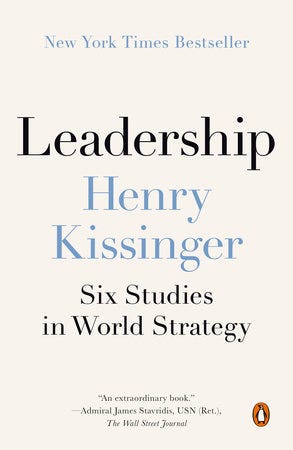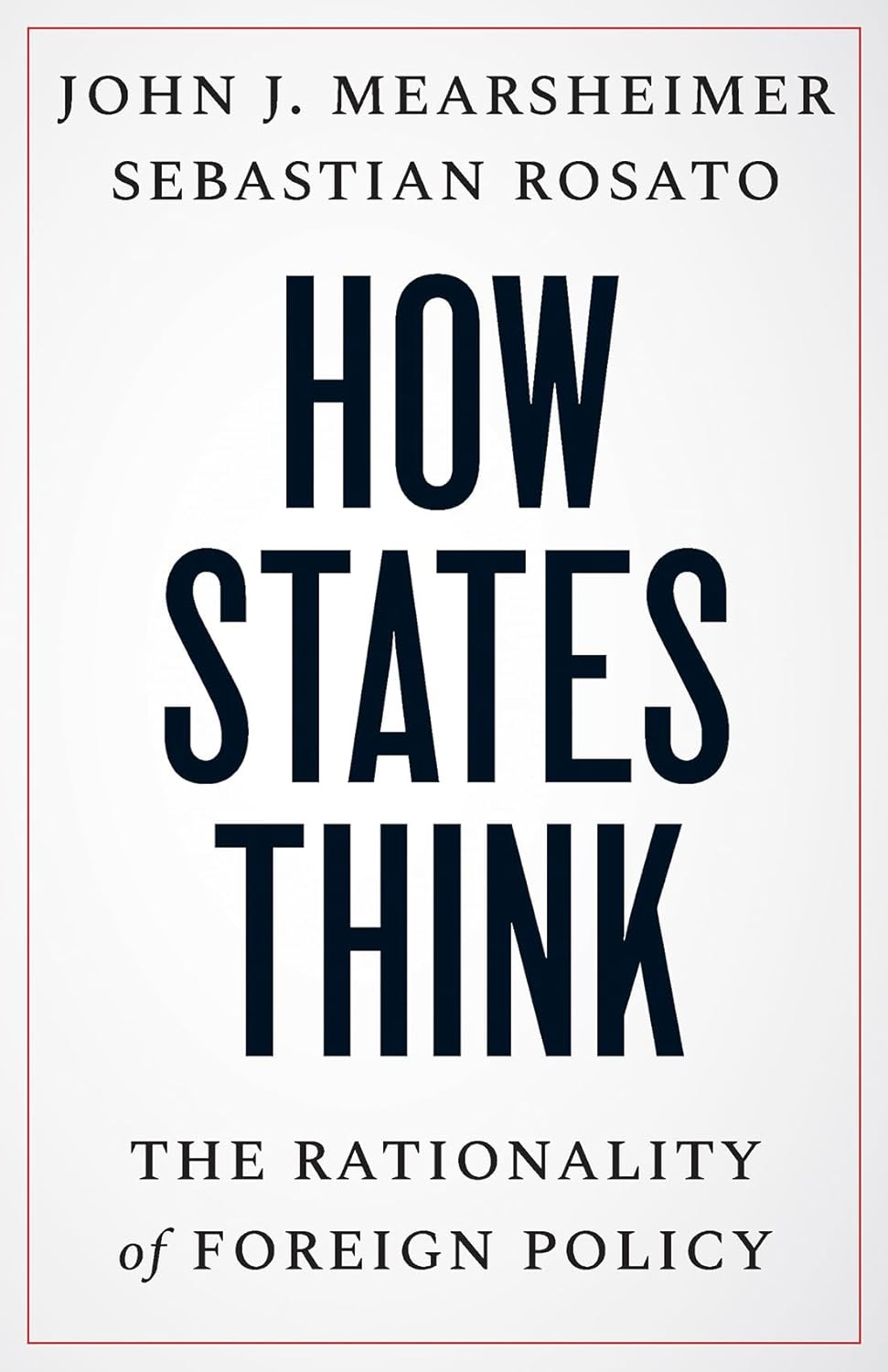Hi, this is pplsartofwar!👋
I’ve had a consistent flow of DMs asking for recommendations for books and papers. I’ll be posting these occasionally as I read more. There’s many, and I think a lot of great strategy books don’t see the light of day.
I’ll be doing this every month or two months.
Happy Reading!!
Recently, I’ve been asked a bit about what strategy books I’d recommend.
That is a very long list, and I’d probably spend a while debating myself which are the most important.
So, I wanted to avoid the usual recommendations like the Art of War, Book of Five Rings, and other texts. But texts that a reader can gain deep insight from - with relatively simple language.
Here’s four I think any first learner to geopolitics and strategy can get started with:
1. Strategy by A.A. Svechin
Why you should read it:
Some books explain what happened. Svechin explains why it keeps happening.
I return to Strategy when wars stretch past their expected timelines, when leaders confuse movement for progress, when entire states chase victories they no longer have the means—or the political time—to sustain.
Most books on military strategy were written for generals. Svechin wrote for states.
He isn’t concerned with battlefield maneuvers. He teaches how to think when outcomes blur, when time extends, when pressure compounds. His insight is austere: strategy must reflect position. Not ideals. Not identity. But material reality—means, constraints, and the tempo of politics.
He reduces war to two logics:
Annihilation: rapid destruction, total and immediate.
Attrition: sustained pressure, measured erosion, endurance over time.
Most statesmen ignore the core truth: the choice is not about will, but proportion. Strategy must match what can be sustained. Misalign ends and means, and collapse follows—slowly, then all at once.
War mirrors politics. The U.S. in Vietnam, Russia in Afghanistan, France in Algeria—all chose annihilation where attrition was required. Each paid the price.
Operational art is the hinge. Strategy fails when tactics serve no strategic logic.
Material capacity is destiny. Overreach ends not in defeat, but in exhaustion.
Duration shapes victory. Sometimes survival is the strategy. Strength lies in endurance, not aggression.
This is why the book matters: strategy fails before the war begins. States pursue short wars in long-war terrain. Leaders chase glory when survival is the wiser course.
Svechin teaches structural thought. Not “How do we win?”—but “What is winning, given our position, our limits, our timeline?”
Why It Still Matters
The most dangerous illusion in modern statecraft is that war remains what it was: a contest of arms, resolved by force, measured in ground taken.
But wars today are stretched across time and domains—fought with economic levers, informational pressure, gray zone maneuvers.
China wages attrition with supply chains. The United States reaches for annihilation through sanctions and drone warfare. Russia bets its survival not on breakthrough, but on the West’s fatigue.
These are not deviations from war. They are war by Svechin’s definition - conflict calibrated against capacity, bent to time.
And that’s what Strategy prepares you to see. The structure beneath the spectacle. The logic beneath the moves. Why one side keeps pushing. Why another keeps bleeding. Why a third stays still.
Where to read it?
Svechin’s books are in the public domain, so easy to get ahold of them either in Russian or English.
PDF: Svechin's Strategy
2. Diplomacy by Henry Kissinger
Why you should read it:
If Svechin teaches how wars unfold, Kissinger explains why they erupt—and why most could have been avoided.
Diplomacy isn’t a memoir, but a detailed framework for how international order survives. At its core is a cold, essential truth: order is not organic. It is built. And order survives only when power and legitimacy are kept in fragile alignment.
Throughout the book, Kissinger emphasizes this fragility about government systems. That they need both force and ideals to create a lasting system. Systems based on force alone breed revolt. Systems grounded solely in ideals collapse under their own illusions.
I think what what matters the most in Diplomacy is that these aren’t just historical case studies. They form a pattern. One that repeats. And in that repetition, the logic of diplomacy becomes clear—anchored in the same lessons, learned and forgotten in equal measure:
Power without legitimacy is feared. Legitimacy without power is ignored.
Diplomacy demands empathy—not sentiment, but the ability to see the world through your adversary’s fears and imperatives.
Stability comes not from dominance, but from equilibrium. The most enduring arrangements are the least maximalist.
Revolutionary states break systems. They seek transformation, not compromise. The task is not to reason with them, but to contain them—until exhaustion or failure tempers their ambitions.
Kissinger walks through history like a surgeon through anatomy. He shows how equilibrium is made, how it’s maintained, and why it so often fails. Not from malice. But from misread incentives, unmet fears, unchecked illusions.
Why It Still Matters
If you look at the feed here on Substack, the news, and Twitter? The world Kissinger warned about has arrived.
Great powers confront each other again using different forms of leverage. Leaders lack the sense what it takes to build legitimacy. So legitimacy fractures across borders and within governments. And unlike Kissinger’s time technology compresses escalation into minutes - space for reflection has vanished and time to ex
So, Diplomacy matters even more because it brings structure into focus. It shows how order is built, why it breaks, and what it takes to hold it together. It does not promise solutions. It teaches you how to see clearly. Its a return to that structural thinking, its reinvention, that will create successful leaders that define this century.
This book offers no comfort. It offers perspective. And in a time of impulsive leadership and collapsing systems, that perspective is strategy.
Where to read it?
Amazon: Diplomacy by Henry Kissinger
3. Leadership by Henry Kissinger
Why you should read it:
If Diplomacy examines systems, Leadership walks through collapse. It is Kissinger at his most forensic - of six leaders of the 20th century who faced governing through rupture - forced to build and act while on the razor edge of internal and external political pressures.
Each faced the edge of failure, and turned around situations that most in the modern world would find difficult - if not impossible . They rebuilt under pressure, with no guarantee of success. Kissinger shows how they bound vision to timing and force to restraint. The most important part is they learned to channel circumstances to their vision, and bend to it.
I’ll emphasize these leaders were not adored. Nor are they clean - all of their legacies remain controversial to this day. But they understood what lesser leaders forget:
The first task of power is not popularity. It is preservation of the future of the nation.
Kissinger profiles six figures, who are interesting in their own right:
Konrad Adenauer, who reintegrated postwar West Germany into Europe by emphasizing continuity, restraint, and incremental trust.
Charles de Gaulle, who reasserted national identity and executive control during a period of institutional fragmentation and colonial retreat.
Richard Nixon, who pursued strategic realignment through engagement with China and arms control with the Soviet Union, while facing growing domestic breakdown.
Anwar Sadat, who recalibrated Egypt’s orientation through a shift toward diplomacy, altering a conflict posture that had defined the region for decades.
Lee Kuan Yew, who built administrative state capacity and consolidated national identity in a small, resource-scarce city-state surrounded by regional volatility.
Margaret Thatcher, who enacted major domestic reform by applying ideological clarity and executive discipline to a stagnant political economy.
Regardless of the leader, each realized that leadership is not measured by applause. But measured instead by the ability, vision, and strength to decide under uncertainty, criticism, and risk.
There’s a few key concepts that are interesting to explore if you read:
Strategy is nothing without timing. These leaders didn’t just know what to do, but when to do it.
Discipline beats brilliance. Success didn’t rely only charisma and popularity, but from endurance and clarity of a national vision.
Constraint is not an excuse. These leaders succeeded not despite limits, but because they mastered them - in some cases used them as an advantage.
If you get deep insight from the book, its that history does not wait. And those who hesitate in moments of rupture are buried by those who act.
Why It Still Matters
This is not a book about greatness. It is a study in burden.
Leadership shows what remains when the scaffolding falls and the weight of the moment shifts to a single figure. It does not celebrate charisma. It studies judgment. The kind that isolates. The kind that does not guarantee reward. Its a study of what makes great leaders - and how their vision and will can transform and reform nations.
These are not stories of triumph, but rather case studies in survival. Six moments when the machine failed and the question was not what to repair, but what to save.
In those moments, vision alone is not enough. Timing matters. Constraint matters. The willingness to act before consensus—matters most of all if you want to be a great leader in the 21st century.
If you want to understand power when everything else breaks, read this. Because the conditions that shaped these leaders are returning. And the luxury of waiting for certainty, for permission, for applause is gone.
Where to read it?
Amazon: Leadership: Six Studies in World Strategy
4. How States Think – John J. Mearsheimer & Sebastian Rosato
Why You Should Read It
The central question in geopolitics is not moral. It is structural. Do states act with reason—or with impulse? Are their decisions coherent, or chaotic?
Mearsheimer and Rosato argue that states, more often than not, do not lurch blindly. They navigate through smoke. Foreign policy might look chaotic from a distance, but up close, it moves like a submarine—slow, deliberate, guided by instruments no one outside can see. Decisions are shaped by a state's perception of reality: what threats seem immediate, what outcomes seem survivable, what options remain when the clock runs down.
This book trains you to track that motion. Not through what a state says, but through what it senses. Not through rhetoric, but through the terrain it believes it stands on. It sharpens your instinct for position—what a state values, what it dreads, what it's willing to risk when the walls start to close.
But logic alone isn’t enough. You need to see how it behaves under pressure—how reason survives in a world full of fog, noise, and fraying maps. That’s what this book gives you.
What States Actually Do
Rationality here doesn’t mean flawlessness. It means goal-directed thinking under uncertainty. States act based on what they know, what they want, and what they believe they can afford to lose.
The book maps that principle across real cases:
Why the U.S. escalated in Vietnam despite knowing the odds
How Germany entered World War I without expecting disaster
Why China and the U.S. both press and pause—aggressive in posture, restrained in timing
Each case lands the same point: these weren’t blunders. They were constrained choices, shaped by imperfect information and hard limits.
Once you start thinking like that, the questions shift. You stop asking, “Why would they do that?”
You start asking, “What did they see? What trap were they trying to avoid? What were they willing to absorb?”
The Logic Beneath the Moves:
That shift in thinking is the real lesson. Beneath the noise, a few constants shape nearly every move:
States act toward outcomes, not narratives. Security, leverage, and survival override everything else.
Rational decisions still fail. Good strategy under bad assumptions collapses.
Ideology and emotion exist—but rarely override material interest.
Foreign policy follows patterns: deter when strong, strike when cornered, align when weak, hedge when uncertain.
To understand a state, read its constraints. Not its personality.
And once you see the patterns, you can’t unsee them. That’s when this stops being theory—and becomes a way of watching the world.
Why It Still Matters
How States Think clears the smoke that hangs over most foreign policy debate. It cuts through mood and myth and shows you how states actually move—quietly, strategically, under pressure.
It teaches you to think like they do. Not as a spectator, but as a planner. What does this state want? What does it fear? What does it think time will do to its position?
Most wars are not surprises. Most alliances are not improvisations. They are the results of pressure building over time—until action is the only path left.
Once you understand that, the noise changes. Headlines become signals. Silence becomes a clue.
Where to read it?
Amazon: How States Think: The Rationality of Foreign Policy
Last Words
If you’re starting out, I’d recommend reading Strategy by Svechin and Diplomacy by Kissinger first.
Svechin teaches you how to think in proportion. Diplomacy gives you the architecture—what holds the world together, and what happens when legitimacy and force drift too far apart.
Those two are the foundation. You’ll read the news differently after them. You’ll start to see why certain decisions get made. Not just what happened at Twitter likes to focus on, but what the alternatives actually were.
Everything else builds on that. Don’t rush through them. Sit with them. They’re dense for a reason.
Thanks for reading, I’ll be publishing more as I make my way though several books.
Thanks for reading.
Before then, if you have any questions or comments, feel free to comment and follow me:
Bluesky: pplsartofwar.bsky.social





![Diplomacy [Book] Diplomacy [Book]](https://substackcdn.com/image/fetch/$s_!wP0V!,w_1456,c_limit,f_auto,q_auto:good,fl_progressive:steep/https%3A%2F%2Fsubstack-post-media.s3.amazonaws.com%2Fpublic%2Fimages%2F4ee6645b-9d49-453b-a8ce-e682854be98d_670x1000.jpeg)


Haven’t read Svechin yet. Thanks for the recommendation! Kissinger’s Diplomacy is already in my collection
Very interesting, thank you.